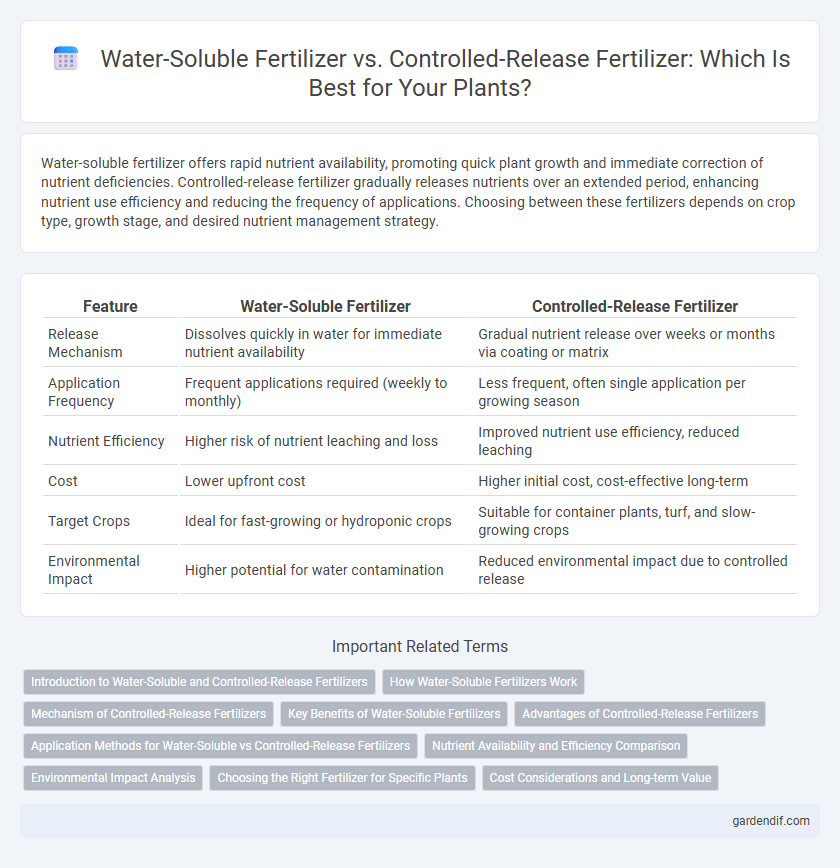
Water-soluble fertilizer vs controlled-release fertilizer Illustration
Water-soluble fertilizer offers rapid nutrient availability, promoting quick plant growth and immediate correction of nutrient deficiencies. Controlled-release fertilizer gradually releases nutrients over an extended period, enhancing nutrient use efficiency and reducing the frequency of applications. Choosing between these fertilizers depends on crop type, growth stage, and desired nutrient management strategy.
Table of Comparison
| Feature | Water-Soluble Fertilizer | Controlled-Release Fertilizer |
|---|---|---|
| Release Mechanism | Dissolves quickly in water for immediate nutrient availability | Gradual nutrient release over weeks or months via coating or matrix |
| Application Frequency | Frequent applications required (weekly to monthly) | Less frequent, often single application per growing season |
| Nutrient Efficiency | Higher risk of nutrient leaching and loss | Improved nutrient use efficiency, reduced leaching |
| Cost | Lower upfront cost | Higher initial cost, cost-effective long-term |
| Target Crops | Ideal for fast-growing or hydroponic crops | Suitable for container plants, turf, and slow-growing crops |
| Environmental Impact | Higher potential for water contamination | Reduced environmental impact due to controlled release |
Introduction to Water-Soluble and Controlled-Release Fertilizers
Water-soluble fertilizers dissolve quickly in water, providing immediate nutrient availability for plants and enabling precise nutrient management. Controlled-release fertilizers release nutrients gradually over time, reducing nutrient loss and promoting sustained plant growth. Selecting between these fertilizers depends on crop type, soil conditions, and desired nutrient delivery speed.
How Water-Soluble Fertilizers Work
Water-soluble fertilizers dissolve quickly in water, allowing nutrients to be immediately absorbed by plant roots, which promotes rapid growth. These fertilizers release essential nutrients such as nitrogen, phosphorus, and potassium directly into the soil solution, enhancing nutrient uptake efficiency. This fast availability supports plants in critical growth stages but requires frequent application due to nutrient leaching risks.
Mechanism of Controlled-Release Fertilizers
Controlled-release fertilizers use polymer coatings or matrix materials to regulate nutrient release by controlling water penetration and diffusion rates, ensuring gradual nutrient availability over time. This mechanism reduces nutrient leaching and enhances efficiency by matching nutrient supply with plant demand during critical growth stages. Controlled-release technology optimizes fertilizer use, improving crop yield and reducing environmental impact compared to water-soluble fertilizers.
Key Benefits of Water-Soluble Fertilizers
Water-soluble fertilizers deliver nutrients rapidly and uniformly, promoting immediate nutrient uptake and faster plant growth. Their high solubility allows precise nutrient management through fertigation, reducing nutrient wastage and enhancing crop yield efficiency. These fertilizers also support quick correction of nutrient deficiencies, making them ideal for intensive cropping systems and greenhouse cultivation.
Advantages of Controlled-Release Fertilizers
Controlled-release fertilizers improve nutrient use efficiency by gradually releasing nutrients, reducing leaching and volatilization losses compared to water-soluble fertilizers. They provide sustained nutrient supply tailored to crop growth stages, enhancing yield quality and minimizing environmental impact. This controlled nutrient delivery also reduces the frequency of fertilization applications, saving labor and lowering overall production costs.
Application Methods for Water-Soluble vs Controlled-Release Fertilizers
Water-soluble fertilizers are typically applied through fertigation systems, enabling precise nutrient delivery directly to plant roots via irrigation. Controlled-release fertilizers are often spread on the soil surface or incorporated into the root zone, providing a slow and steady nutrient supply over time. These distinct application methods affect nutrient efficiency, timing, and labor requirements in agricultural practices.
Nutrient Availability and Efficiency Comparison
Water-soluble fertilizers offer rapid nutrient availability, quickly dissolving in water to supply essential elements like nitrogen, phosphorus, and potassium directly to plant roots for immediate uptake. Controlled-release fertilizers release nutrients gradually over an extended period, enhancing nutrient use efficiency by minimizing leaching and volatilization losses. This slow-release mechanism aligns nutrient supply with plant demand, improving overall fertilizer efficiency and reducing environmental impact.
Environmental Impact Analysis
Water-soluble fertilizers provide immediate nutrient availability but often lead to higher risks of nutrient leaching and water pollution. Controlled-release fertilizers release nutrients gradually, reducing runoff and minimizing environmental contamination. Studies show controlled-release formulations significantly lower nitrogen losses and greenhouse gas emissions compared to water-soluble options.
Choosing the Right Fertilizer for Specific Plants
Water-soluble fertilizers provide immediate nutrient availability, ideal for fast-growing plants requiring quick nutrient uptake, such as leafy vegetables and flowers during peak growth stages. Controlled-release fertilizers gradually supply nutrients over an extended period, benefiting plants with longer growing cycles, like fruit trees and shrubs, by reducing nutrient leaching and minimizing the risk of nutrient burn. Selecting the right fertilizer depends on plant type, growth phase, and soil conditions to optimize nutrient efficiency and promote healthy development.
Cost Considerations and Long-term Value
Water-soluble fertilizers offer lower upfront costs and immediate nutrient availability, making them ideal for short-term crops and quick growth responses. Controlled-release fertilizers have higher initial expenses but provide prolonged nutrient release, reducing the need for frequent applications and lowering labor costs over time. The long-term value of controlled-release fertilizers lies in enhanced nutrient use efficiency and improved crop yields, which can offset the initial investment through sustained plant health and reduced environmental impact.
Water-soluble fertilizer vs controlled-release fertilizer Infographic

 gardendif.com
gardendif.com